Social Analysis (CHP)
Introduction
The social issues regarding implementing CHP at Lafayette College are surrounded by a much larger framework that include federal energy policy, global climate change, and energy independence as well as energy production and consumption. When analyzing the relevant social contexts at Lafayette College, additional issues such as the age and condition of the equipment at the College’s steam plant, the reliability of the grid and the College’s facilities during power outages, the College’s carbon footprint and standing as a “green campus”, as well as the social hierarchy that exists within the College’s administration and the Master Planning Committee were all taken into consideration.
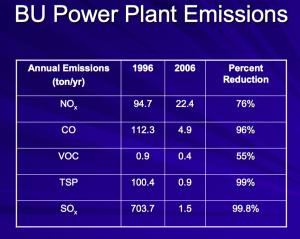
When researching CHP in the Lehigh Valley area, a few examples came up, such as the use of CHP at St. Luke’s in Bethlehem. However, the CHP system at St. Luke’s is not a comparable analogy, as hospitals are required to have alternate sources of energy to maintain temperatures to protect patient health and safety, and for the safe and sanitary storage of provisions per the proposed DHHS rule (National Archives and Records Administration, 2013).
Other schools of similar size and in the surrounding area have converted to CHP, including a few Colleges and Universities in Pennsylvania. For example, in 1998, Bucknell University converted from coal fired boilers to a steam-run cogeneration plant that supplies all of the campus’s steam and electricity needs. By switching to CHP, and reducing the amount of electricity purchased, Bucknell University reduced their emissions from more than 60,000 Metric Tons of carbon dioxide equivalents (MTeCO2) in 1996 to 37,756 MTeCO2 in 1997 (Power Plant, n.d.). Additionally, the steam plant currently saves the University over one million dollars a year in utility costs (Buczko, 8). The fact that a school comparable to Lafayette College implemented CHP on their campus almost two decades ago raises the following question, why hasn’t CHP been implemented at Lafayette College?
Federal & State Policy
In an effort by Federal and State Governments to enhance emergency preparedness and ensure continued progress towards addressing grid and infrastructure resilience, government regulators, emergency planners, and those in the energy and electricity sector have been working together to help reduce regulatory barriers to CHP (U.S. Department of Energy & Environmental Protection Agency [EPA], 2013, p.3). Currently, there are several factors driving the adoption of CHP, including historically low natural gas prices, favorable Federal tax programs, such as Investment Tax Credits (ITC), national energy security, U.S. government regulatory support, and resilience to future storms of similar magnitude to Hurricane Sandy (EPA, 2013).

Mingora, Kevin. (2012, October). The Morning Call.
On October 30, 2012, Hurricane Sandy swept across some of the nation’s most populated communities along the Northeast and Mid-Atlantic, leaving millions of people without access to electricity, utilities, or telecommunication. The resulting infrastructure destruction and the subsequent disruptions caused by super-storm Sandy highlighted the need for U.S. infrastructure investment. As a part of the Hurricane Sandy Rebuilding Task Force, some states affected by Hurricane Sandy, such as New York and New Jersey, have initiated programs to promote CHP (EPA, 2013).
Although Pennsylvania currently does not have a CHP goal, grant or incentive program set up, the Pennsylvania Public Utilities Commission is exploring whether Pennsylvania should adopt some of the programs and changes that have been made in other states to encourage CHP development (Pennsylvania Public Utility Commission [PPUC], 2016, 4). Due to its low cost and availability, fracking in Pennsylvania has led to an increase in use of natural gases in Pennsylvania. For an in-depth analysis of the natural gas market, see the Economics section. Therefore, the creation of policies and programs that promote CHP in Pennsylvania is critical to the deployment of CHP, as “investment in CHP, in the absence of state, federal and other investment subsidies, is largely driven by the cost of electricity” (PPUC, 2016, p.4).
Potential Benefits of CHP at Lafayette College
Following Hurricane Sandy, the College remained closed for for almost a week due to power outages (Superstorm Sandy, 2012). In recent years, the College has experienced multiple power outages as a result of storms or severe weather conditions, including an 18-hour outage this past October (Marshall, 2016; Public Safety, Personal Communication, October 28-29, 2016).
CHP not only has environmental benefits and offers significant cost savings, but it also provides reliable primary and emergency power generation for both electricity and heating. Due to CHP’s resiliency, many colleges and universities have taken an interest in it. According to the U.S. Department of Energy & Environmental Protection Agency, “CHP played a successful role in keeping a number of college campuses, multifamily housing, critical medical facilities, sewage treatment plants and other facilities running during the storm and its aftermath,” (EPA, 2013 p.2) as it allowed crucial infrastructure and other facilities to continue their operations when the electric grid went down. This stability—i.e. being able not to interrupt day-to-day business—offers Lafayette benefits in addition to monetary savings. Some of these benefits include not having to cancel class, close dining halls, or send students home due to the unsafe conditions of a campus without power. Furthermore, the reliability that CHP has to offer is not something the College will have while solely relying on the grid.
American College & University Presidents’ Climate Commitment
In January of 2008, Lafayette College President Daniel Weiss signed the American College & University Presidents’ Climate Commitment (ACUPCC), thereby uniting Lafayette College with a coalition of colleges and universities across the United States that have committed to reducing their greenhouse gas emissions and work towards achieving climate neutrality (Lafayette College, 2015, p.6; Lafayette College, 2011, p.1). The ACUPCC aims to address climate disruption due to human activities by better preparing future generations to protect the environment by integrating sustainability into research, operations, and curriculums. Institutions are provided with a framework to implement their plans in order to meet the requirements detailed in the ACUPCC (Lafayette College, 2015, p.6).
Greenhouse Gas Inventory
In accordance with the ACUPCC, Lafayette College has prepared and completed three Greenhouse Gas Inventory Reports. These reports provide insight about possible emission reduction strategies, as the reports analyze information about Lafayette’s emissions since 2007 (Lafayette College, 2015, p.5). The most recent GHG inventory calculates years 2005 through 2013, and includes greenhouse gas emissions associated with electricity and steam consumption, fuel use, agricultural releases, solid waste management, fugitive refrigerant releases, traffic commuting, and air travel for the entire Lafayette College campus (Lafayette College, 2015, p.10). Some of its most significant findings were that the two largest sources of greenhouse gas emissions were from the purchase of electricity from Metropolitan Edison for campus usage and from the purchase of natural gas and fuel oil for the on-site boiler plant, which fulfills most of the College’s heating and hot water needs (Lafayette College, 2015, p.26). The report concludes by stating that, “Increasing the efficiency of equipment for current operations that produce high greenhouse gases, meaning reducing the current and future consumption of fossil fuels as a whole” should be considered in the future to reduce Lafayette’s carbon footprint (Lafayette College, 2015, p.29).
Energy Audit
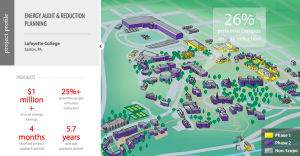
In order to more accurately quantify the greatest contributors to the College’s emissions, Entech Engineering conducted a comprehensive energy audit in 2007 (Lafayette College, 2015, p.5; Lafayette College, 2011, p.10). This energy audit, which investigates the amount of energy consumed by campus facilities, is critical to understanding our College’s energy production, consumption, and efficiencies/losses, and therefore is essential to the development and implementation of a strategic carbon reduction program.
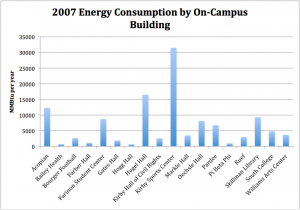
This study found that, in 2007, the College’s buildings accounted for over 86% of campus emissions. Of these emissions, 51 on-campus buildings accounted for over half of all campus emissions (Lafayette College, 2011, p.18). These fifty-one buildings were examined to determine the energy consumption and the annual energy cost for each building, as well as how much each building contributes to the campus carbon footprint (Lafayette College, 2011, p.18). Figure 1 shows that, “The most significant contributors to Lafayette’s emission are the science and engineering buildings, Acopian Engineering Center and Hugel Science Center, and the Kirby Sports Center, which require large volumes of conditioned air” (Lafayette College, 2011, p.18). Entech concluded that in order for Lafayette College to make significant reductions in campus emissions, “the College must address its most energy intensive operations” (Lafayette College, 2011, p.18).
Climate Action Plan (CAP)
As a result of the 2007 campus energy audit, 485 energy conservation measures (ECMs) were developed and transferred to the College’s Energy Planner, which provides an economic analysis of each ECM in order to help the College determine which projects to execute and how to schedule them (Lafayette College, 2011, p.3). Implementation of these ECMs are part of the Campus Emissions Reduction Plan to reduce our campus’s greenhouse gas emissions 20% by 2021, relative to the College’s baseline 2007 levels (Lafayette College, 2011, p.2). These ECMs are listed in Lafayette College’s Climate Action Plan (CAP), a plan that was created in November of 2011 and details specific strategies that the College will employ to reduce greenhouse gas emissions and ultimately achieve climate neutrality (Lafayette College, 2011, p.2).
In order to make the goals of the Climate Action Plan realistic and achievable, “the College has chosen to work toward climate neutrality by first focusing on reducing its energy consumption rather than purchasing renewable energy credits to offset all of its emissions. A healthy environment does not have to come at the expense of the institution’s financial performance; these two aims are not mutually exclusive” (Lafayette College, 2011, p.6). The Climate Action Plan also states, “The College has committed to invest $400,000 per year for 10 years (2010 through 2020) to finance the scheduled ECMs. The scheduled ECMs are those projects with the shortest payback period and largest MtCO2e reductions, thus allowing the College to quickly realize the expected cost savings and reinvest those savings if desired” (Lafayette College, 2011, p.3). While finances are undoubtedly important when considering whether or not to undertake a project, these excerpts illustrate how the College’s priorities are heavily reliant on project financing, and as a result, making our College a ‘greener campus’ is viewed to be of less importance.
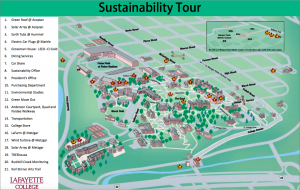
Two of the short-term goals listed in the Climate Action Plan moving forward were to, “Update the Climate Action Plan in 2013 to reflect the decisions and progress made after completing the short-term goals” and to “Update the Climate Action Plan every two years using the Energy Planner” (Lafayette College, 2011, p.4). Unfortunately, the Climate Action Plan has not been updated since its original creation in 2011, and as a result, information regarding decisions and progress that has been made since that time was difficult to find, as most of the information on the College’s website regarding sustainable energy and electricity initiatives have not been updated since 2012 (Sustainability Projects, n.d.; Current Sustainability Initiatives, n.d.).
The College’s Climate Action Plan also states that their goals were to evaluate the technical and economic feasibility of installing renewable energy or cogeneration, and to update the campus facility condition assessment to identify maintenance and capital renewal projects that were deferred in order to identify opportunities to improve energy efficiency in those systems by December of 2013 (Lafayette College, 2011, p.4). In the College’s Greenhouse Gas Inventory, it states that, “This inventory, in conjunction with the campus-wide energy audits, will be the foundation for the development and implementation of a plan with phases and target dates as the College pursues climate neutrality” (Lafayette College, 2011, p. 5). This analysis shows that both the 2013 Greenhouse Gas Inventory and the Energy Audit recommend reducing the College’s emissions by improving upon the campus’s utilities and infrastructure. Considering that the College was aware of the benefits of CHP back in 2011, we can only assume that the College’s administration decided not to implement CHP due to financial concerns.
Z&F Consulting’s “Energy Sufficiency” Study
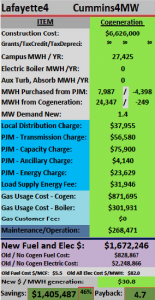
In the aftermath of Hurricane Sandy, Lafayette College administration took an interest in CHP. In 2012, Z&F Consulting conducted an “Energy Sufficiency” study of Lafayette College and determined that creating a cogeneration plant on campus would reduce the College’s carbon emissions by 35%. Z&F Consulting found that it would cost $6,260,000 to construct and implement a cogeneration plant at Lafayette College, as shown in Figure 2. Unfortunately, the estimated initial costs to implement CHP would exceed the $400,000/year maximum investment earmarked to reduce the College’s GHG emissions. The study concluded that CHP would reduce energy costs by 35%, saving the College $1,120,000/year. Based on these savings and increased efficiency, it is difficult to understand why the College would not implement CHP back in 2012. According to a few faculty members, the Lafayette College administration ultimately decided not to implement CHP due to the difficulty in procuring fuel and the uncertainty of the fuel market (B. Ferretti, personal communication, October 13, 2016; M. Wilford-Hunt, personal communication, October 19, 2016). For further details about the natural gas market, see the Economics Analysis.
Energy Policy
One of the biggest issues with the college’s current Campus Energy Policy is that much of it focuses on the consumption aspect of the energy discussion, rather than the production side. For example, some of the “Specific Measures” listed in the Campus Energy Policy includes the following: “Windows and doors of the conditioned spaces should be kept closed when the systems are running,” “Personal computers, other office equipment, lights, window air conditioners and personal heaters should be turned off when not in use,” and “The use of personal heaters and air conditioners is discouraged (unless medical conditions deem it necessary).” These policy measures are limited in enforcement, as they are heavily reliant on responsible consumption practices by students, staff, and faculty members.
Additionally, many of the “Specific Measures” listed in the Campus Energy Policy are vague, and include phrases such as “should be considered” and “application where warranted and possible” (Lafayette College, n.d.). The use of words such as “should” minimizes the impact of the policy statement, and reflects the lack of concrete goals our college currently has in place. For instance, under the “New Renovation & Construction” section, it states that, “All new renovations and construction should be designed and built to minimize energy use,” however, it does not detail what is considered to be minimizing energy use (Lafayette College, n.d.). Similarly, the only mention of Alternative energy sources in the college’s Campus Energy Plan is in the “New Renovation & Construction” section, and states that alternative energy sources, such as co-generation, should be considered along with other strategies that could decrease building energy consumption (Lafayette College, n.d.).
Lafayette College’s limited motivation to implement CHP could be attributed to the lack of concrete policy initiatives we currently have in place. The College would likely be more motivated to implement CHP if there was a statement in the College’s Energy Policy that stated, for example, that ‘Lafayette College will have 30% of their energy production be from alternative fuels or cogeneration by 2020.’
Another problem is that upgrading our facilities is contingent upon available funds. With the numerous projects in development and under construction at Lafayette College, we can assume that funds are available. The issue is that Lafayette College administration does not view CHP as a priority.
Campus Master Plan
There are two ways the College can execute a project, as shown in Appendix A. For further information regarding the specific processes that determine how changes are made and which projects are carried out, see the Policy Analysis section. One way a project can be carried out is through the Campus Master Plan. Every fall, the President’s Cabinet asks the department heads for a list of projects they would like to see on campus. The Cabinet members meet with each department head to discuss priorities and then rank the projects in their division based on their priority. The cabinet compiles a list of all the projects, and prioritizes them so that the Master Planning Committee can decide on a capital project in December (Personal Communication, October 19, 2016). The Master Planning Committee consists of students, faculty, staff, alumni, trustees, City of Easton, and residents of College Hill. However, yearly reviews of the Master Plan, known as the Framework Plan, do not include all of these committee members; oftentimes, only trustees and certain faculty and staff members are in attendance.


Of course, funding has a great impact in determining which projects will be carried out. The Controller’s office decides the overall budget for a project, which is typically three to four million dollars (M. Wilford-Hunt, personal communication, October 19, 2016). Another way a project may be initiated is through donations, borrowing or gifts; these projects are donor or fund driven. Oftentimes, people who donate money give it to a specific division or donate it for a specific purpose (M. Wilford-Hunt, personal communication, October 19, 2016). Mary Wilford-Hunt, Director of Facilities Planning and Construction, thinks it may be difficult to get people to donate for CHP due to lack of knowledge about the subject-matter, but she is hopeful that someone would be willing to donate because it is such a ‘green’ initiative (personal communication, October 19, 2016).
Institutions generally like to put money into things that attract students, media, and future funding. A system such as CHP is not one of the more visible ways for the college to spend its money, compared to new buildings on campus such as the Oeschle Center for Global Education, the Arts Plaza, and the new Integrated Science Center. However, many rising college students look for schools that have progressive sustainability measures in place.
Interest in sustainability has been rising over the last few years with new clubs and initiatives giving rise to LaFarm, Lafayette Compost Program, and a new dining service provider. Student petitions and protests outside of Markle Hall in 2015 helped secure the hiring of the College’s first Sustainability Coordinator. This past November, Lafayette College welcomed both the new Sustainability Coordinator and Energy Manager.
Creating a cogeneration plant on campus would also provide a variety of educational opportunities for current students at Lafayette College, whether that be through volunteer work, independent research, or part of a course curriculum. Moreover, having a cogeneration plant on campus would be a great way to integrate the liberal arts and engineering programs, thereby creating an interdisciplinary experience that is unique to Lafayette College.
Campus Expansion
On February 24, 2016, President Byerly announced the college’s plan to expand the size of our campus, faculty, and student body over the next six to eight years to be competitive with the best institutions in the United States (Byerly, 2016). Although many of the buildings that have been constructed on campus over the past few years meet energy efficiency standards, they also tend to demand more power due to their size and function—as previously discussed in “Energy Audit” subsection. As the college continues to grow, in both numbers of people and numbers of buildings, our energy demand will also continue to increase. Therefore, it is imperative that the college considers implementing a system such as CHP that would address our nation’s growing concerns about greenhouse gas emissions.
For an update on where we are in the current stage of the Master Plan and facilities planning, check out President Byerly’s update on “Accomodating Growth” from August of 2016.
Conclusion
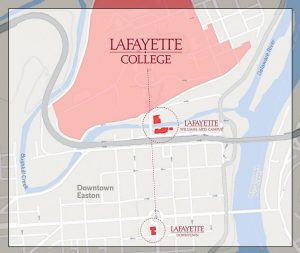
Current issues surrounding the College, such as wanting to be a more self-sustaining campus and power outages due to storms and severe weather conditions, are not new issues for the school. Through our research, we have determined that one of the reasons why the College has not implemented CHP is due to the College’s lack of a strong environmental identity, meaning that there is a large discrepancy between what we want to be doing as a College versus what we are doing as a College. This discrepancy may be due to the fact that even though President Weiss signed the Presidents’ Climate Commitment, limited action was taken during his time at Lafayette to make it a more sustainable campus (Sustainability Projects). However, President Byerly seems to have a much more active environmental focus (B. Cohen, personal communication, December 8, 2016). In recent years, the College has made great efforts to make our campus more sustainable and environmentally friendly. Yet, initiatives that address the College’s energy consumption and production are minimal. We are hopeful that with the hiring of our College’s first Sustainability Coordinator and Energy Manager, this will change.
Considering that our College’s facilities need to be moved in order to construct the new Integrated Science Center, and that the College plans to expand the size of our campus, faculty, and student body over the next few years, now is the perfect opportunity to implement CHP on campus. Implementing CHP at Lafayette College is feasible, but it is heavily reliant upon student understanding, interest, and initiative, as well as available funds that need to be specifically geared towards updating our College’s facilities. More importantly, it is dependent upon whether Lafayette College’s administration makes CHP a priority.
In order for CHP to have any future potential at Lafayette College, it is imperative that the college views implementing CHP not just as a way for the college to save money, but also as an opportunity for our institution to be a model for healthier energy use practices. As one of the top ranked institutions in the United States, it is not just our goal, but it is our obligation to be leaders in taking steps to reduce our climate impact, and pave the way for others.
